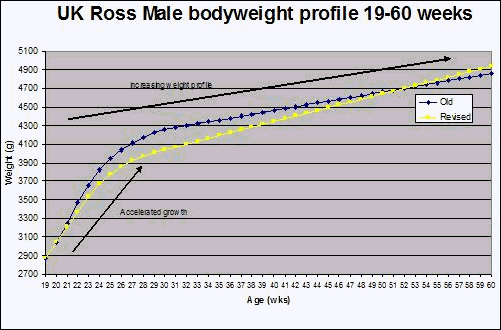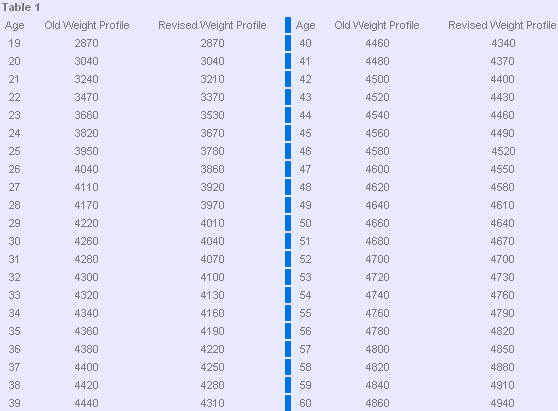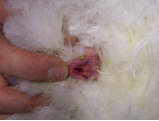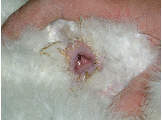



The Management of Male Breeders
By Lindsay Broadbent, UK Customer Account Co-ordinator, Aviagen - The objective in managing male breeders is to rear sufficient good quality males to mate with females at 19 weeks and thereafter maximise fertility through the lay period. Good quality means that males have the potential to maintain high levels of fertility through the production period. Sufficient will mean anywhere between 8 and 10 percent of the female number at 23 weeks.
From evidence we have collected in the UK and other information available, the emphasis on managing the male breeder has changed from a blinkered view of absolute weight profile to a combination of weight profile, skeletal size, uniformity, body condition and mating ratio.
The key message is that weight and feed profile increase from day old to depletion. The weight profile in lay has been modified to ensure that the correct growth rate is more easily achieved and to ensure that body condition is not compromised with age.
Early Growth
It is important that the chicks start well, a good quality starter crumb to 14 days then a starter pellet through to 6 weeks. Weight targets must be met through 7, 14, 21 and 28 days if the birds are to develop good early frame size, feather cover, cardio vascular and immune systems (Fig. 1). A sound skeleton set here will be the building block for the mature male in the breeding house. If weight profiles are met by 28 days, the uniformity will be maximised and the requirement for grading in the following weeks will be minimal.

It is good practice to select the candidates for mating up at 5 weeks. Selection here for a tight population of 100% evenness (CV of 5-7%) to carry forward to the breeding house, plus a few spares for unforeseen losses. Any birds with leg or skeletal defects should be removed here along with undersized and poorly feathered birds. Maintaining uniformity from this point requires the correct stocking density, feed space and feed allowance. If required a second grading at 10 weeks may prove useful. But after this time there is no benefit in grading as the skeleton is 85% grown and leaves no opportunity for the manager to influence skeleton size further.
Stocking density in the range of 3-5.5 birds per m2 is optimal. Feed space from here on must increase up to 10cm per bird if fixed systems are used, then to 15 cm by 10 weeks and 18 cm at 15 weeks.
From 10 weeks, it is critical that you do not lose impetus in growth rate. Development of the sertoli cells begins around this time and testes development continues through to sexual maturity at 23 weeks. From 15 weeks there is rapid development of the testes and growth profiles must be followed or fertility will be delayed or lost. (Fig. 1)
Because of the continuing selection for feed efficiency in male lines, you may need to use a more dilute, bulky diet to increase feed volume in mid rear to ensure adequate intakes of nutrients needed for correct growth and development.
Before transfer to the laying house, the final selection of males must be made. The selected males will be uniform with an upright posture and have grown to the correct profile. Males with leg or skeletal defects, sharp, hooked, short or uneven beaks must also be rejected as either mating will be unsuccessful or injury to the females will occur. The stage of development should be matched as closely to the females as possible using comb, wattle and feather maturity as indicators.
It is best practice to move the males to the laying house 24 hours before the females. This helps the males find feed and water more easily, critical if the growth profile is to continue on track. The males must be fed to follow the growth profile through to 30 weeks to ensure sexual and physical maturity. (See Fig. 2)

Loss of growth rate here will delay early fertility and adversely affect late fertility. By 24 weeks I would expect males to be on 135 g of feed per day, increasing by 1 g per week through to depletion. But maintaining the weight profile is paramount, feed levels will depend on nutritional values and efficacy of the separate feeding system
It is important here to remind you that male feed space should remain constant, with feeder space removed as male numbers go down. This will prevent an uneven population of males developing.
The management principles and procedures used to manage males in the post-peak period are similar to those used in the pre-peak period. Male weight and body condition are controlled by adjusting feed quantity so that a slow constant increase in weight (30g/week) is achieved as the male grows older. The revised weight profile in lay for UK Flocks is shown below. (See Table 1)

Sample males should be weighed frequently to ensure that this is achieved. Each sample male should be evaluated to determine if it is maintaining the ideal body condition in order to breed. Changes in flock feed quantities will be made based on the sample evaluated. A sample size that is too small can mislead the manager.
After 30 weeks of age, male weekly body weight gain should be approximately 30 grams when averaged over a three week period. Body weight data should be used with other husbandry information to make feed allowance decisions. The amount of feed the males can vary greatly depending on the ability of the feeding system to keep males and females from eating each others feed. With excellent control, male feed allowance is normally in the range of 130-160 grams per male/day and should be always increasing through the male's life. As a rough guide, an increase of 1g per week, from 30 weeks of age, should maintain growth and condition. Feed amounts needed depend on the security of the separate feeding systems and the energy level of the feed.
Both underfeeding and overfeeding of males are possible, and can cause problems. Underfeeding is more common after 40 weeks of age. Males require food for maintenance, growth and condition and to maintain mating activity. If nutrition is marginal, the first thing to go will be mating activity.
The males will begin to appear dull and listless, showing excess feather loss, reduced fleshing, reduced mating activity and reduced less crowing. In addition, vent colour will become paler and the variability of vent colour between males will widen. When this occurs, the more active males will work for a short period, using their body reserves, but other males will cease to function. If the condition reaches the final stages, a significant number of birds will not recover. Overall, this will result in reduced fertility.
Vent Colour
 Red = Working well |
 Pale = Performance falling off, less mating |
On observing any of these symptoms, a number of corrective steps must be taken:
- Check the male feeder is not available to females.
- Check that male feed space is constant (18 cm or 7-9 males per pan)
- Feed allowance should be increased 5-10 g /day).
- The accuracy of weekly average weight gain data should be checked and a sample of the birds reweighed if in doubt.
Overfeeding of males will lead to males that have excessive breast development and excessive weight which can lead to damage to females, more stress on the male's joints and foot pads.
Routinely cull individual males according to their physical condition.
Males with poor feet, poor legs, poor fleshing, poor comb and vent colour should be culled as seen on a daily basis. As males are removed feed space must be adjusted to remain constant.
The technique of managing male breeders is not 'rocket science'. Attention to detail, monitoring and maintaining the correct weight gain and profile will reduce the possibilities of reduced fertility levels. Observing behaviour and reacting to it will help in maintaining a flock of quality males which will maximise fertility to the end of lay.
The profile discussed here is based on UK results and is intended for producers in the UK. Outside the UK discuss the subject with your local Aviagen Technical Manager with a view to tailoring the profile for local environmental conditions, nutritional inputs and management practices.
Source: Aviagen, Courtesy of Poultry World, October 2005









